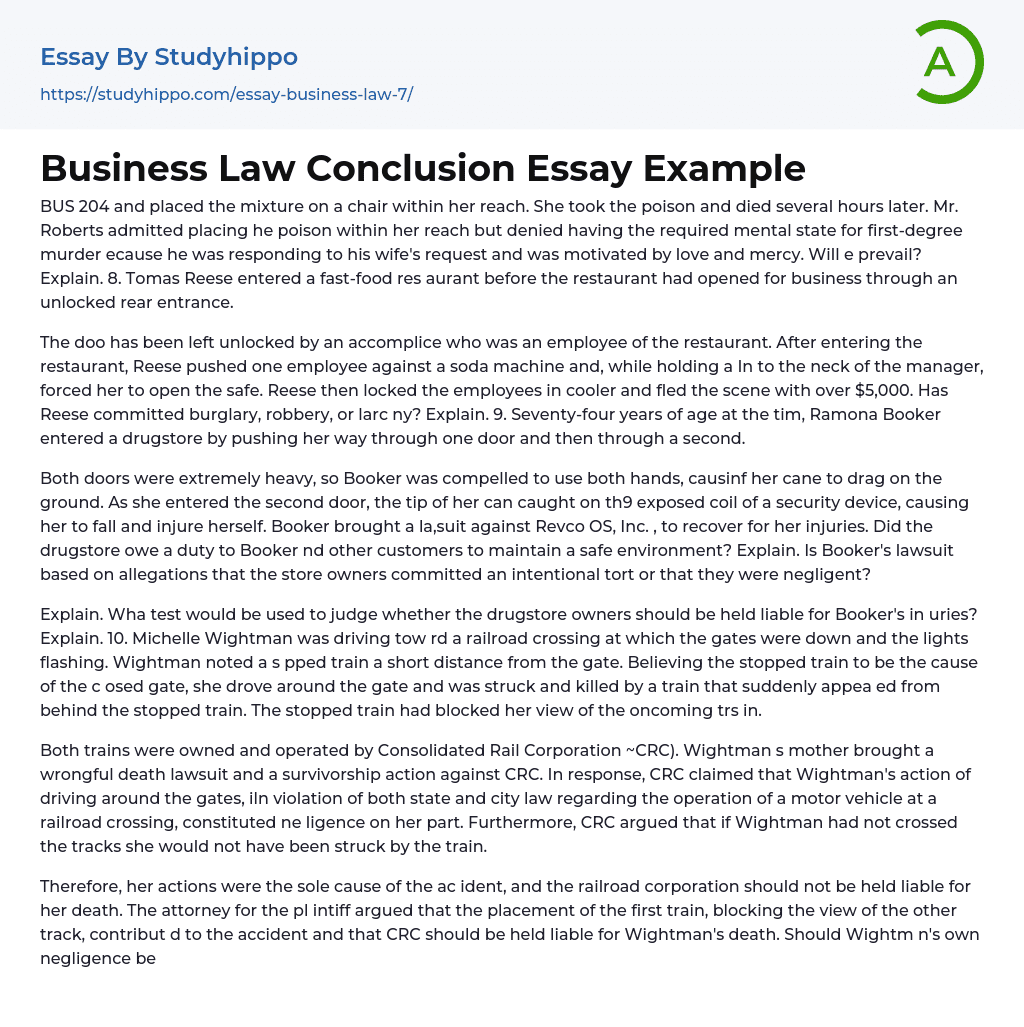BUS 204 and placed the mixture on a chair within her reach. She took the poison and died several hours later. Mr. Roberts admitted placing he poison within her reach but denied having the required mental state for first-degree murder ecause he was responding to his wife's request and was motivated by love and mercy. Will e prevail? Explain. 8. Tomas Reese entered a fast-food res aurant before the restaurant had opened for business through an unlocked rear entrance.
The doo has been left unlocked by an accomplice who was an employee of the restaurant. After entering the restaurant, Reese pushed one employee against a soda machine and, while holding a In to the neck of the manager, forced her to open the safe. Reese then locked the employees in cooler and fled the scene with over $5,000. H
...as Reese committed burglary, robbery, or larc ny? Explain. 9. Seventy-four years of age at the tim, Ramona Booker entered a drugstore by pushing her way through one door and then through a second.
Both doors were extremely heavy, so Booker was compelled to use both hands, causinf her cane to drag on the ground. As she entered the second door, the tip of her can caught on th9 exposed coil of a security device, causing her to fall and injure herself. Booker brought a la,suit against Revco OS, Inc. , to recover for her injuries. Did the drugstore owe a duty to Booker nd other customers to maintain a safe environment? Explain. Is Booker's lawsuit based on allegations that the store owners committed an intentional tort or that they were negligent?
Explain. Wha test would be used to judg
whether the drugstore owners should be held liable for Booker's in uries? Explain. 10. Michelle Wightman was driving tow rd a railroad crossing at which the gates were down and the lights flashing. Wightman noted a s pped train a short distance from the gate. Believing the stopped train to be the cause of the c osed gate, she drove around the gate and was struck and killed by a train that suddenly appea ed from behind the stopped train. The stopped train had blocked her view of the oncoming trs in.
Both trains were owned and operated by Consolidated Rail Corporation ~CRC). Wightman s mother brought a wrongful death lawsuit and a survivorship action against CRC. In response, CRC claimed that Wightman's action of driving around the gates, iln violation of both state and city law regarding the operation of a motor vehicle at a railroad crossing, constituted ne ligence on her part. Furthermore, CRC argued that if Wightman had not crossed the tracks she would not have been struck by the train.
Therefore, her actions were the sole cause of the ac ident, and the railroad corporation should not be held liable for her death. The attorney for the pl intiff argued that the placement of the first train, blocking the view of the other track, contribut d to the accident and that CRC should be held liable for Wightman's death. Should Wightm n's own negligence be a complete bar to the plaintiffs recovery of damages in this case? E plain.
- Accounting essays
- Marketing essays
- Automation essays
- Business Cycle essays
- Business Model essays
- Business Operations essays
- Business Software essays
- Corporate Social Responsibility essays
- Infrastructure essays
- Logistics essays
- Manufacturing essays
- Multinational Corporation essays
- Richard Branson essays
- Small Business essays
- Cooperative essays
- Family Business essays
- Human Resource Management essays
- Sales essays
- Market essays
- Online Shopping essays
- Selling essays
- Strategy essays
- Management essays
- Franchising essays
- Quality Assurance essays
- Business Intelligence essays
- Corporation essays
- Stock essays
- Shopping Mall essays
- Harvard Business School essays
- Harvard university essays
- Trade Union essays
- Cooperation essays
- News Media essays
- Waste essays
- Andrew Carnegie essays
- Inventory essays
- Customer Relationship Management essays
- Structure essays
- Starting a Business essays
- Accounts Receivable essays
- Auditor's Report essays
- Balance Sheet essays
- Costs essays
- Financial Audit essays
- International Financial Reporting Standards essays
- Tax essays
- Accountability essays
- Cash essays
- Principal essays




